
- Featured News
- Owner Profile: Steve Eddleston and the 12-meter Weatherly
- risingTAdmin
- October 22, 2020
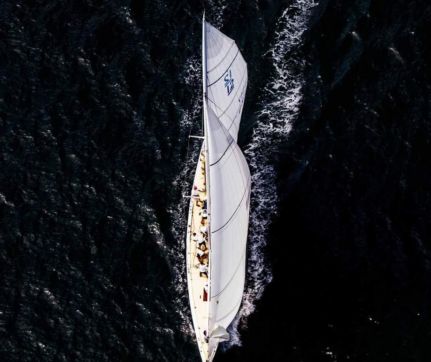
Rod Harris Photography
For Steve Eddleston, sailing had never been an option. Born in the UK, he grew up in New Zealand and had never considered sailing despite Auckland being one of the “most pristine sailing areas in the world.” With a love for music, Eddleston was “a musician and musicians don’t think about just going down to the dock and jumping on a boat.”
It wouldn’t be until the late nineties after a very successful career working with computers and programming that he was drawn to something else entirely. “I have only ever worked on computers. It’s all very binary. It’s challenging yes, but I was afraid that I would get to my sixties and realize ‘Hey! I’ve never done anything different.’"
It was at that moment in his Maine home looking out on the water that “It hit me. Sailing. Sailing is all analog, computers are digital. With sailing it's all feelings, and currents and tides. It is all physical and gut, feeling the wind on your face.” With that, Eddleston grabbed an Uncle Henry magazine at the supermarket, and purchased his first sailboat from the sailing section, a fourteen foot Hobie Cat.
“Of course I think now, ‘great idea Steve, you dummy!’ When you’re starting out sailing you should probably get something a little slower.” While his first sail of the new Hobie Cat lasted about “50 yards before I was thrown off,” Eddleston soon became a talented self-taught sailor, regularly competing in the Maine regatta circuit with his son.
In 2008, he decided to “quit computers,” and while his original dream of the next chapter centered around Hawaii, many mai tais, and “lots of Jimmy Buffet playing,” Eddleston soon embarked on another passion project originating from his love of running.
Finding “Planet Fitness,” Eddleston was tasked with building eight gyms in eight years. Soon however, it was ten years and fifteen gyms later. Seeking “something different” to do as a special party for his management staff, Eddleston who was a member of the Herreshoff Marine Museum and lover of maritime history, saw that the iconic schooner Eros was available for charter.
Eddleston and his staff competed in the 2018 Herreshoff Regatta, chartering Eros for those two days. In 2019, he again chartered Eros competing in the regatta once more, a last hurrah as the sale of his gyms was on the near horizon. It was through the owners of Eros that Eddleston was connected to a wooden boat surveyor who when he learned of Eddleston interested in purchasing “something a little smaller than a schooner,” posed the question “well, what about the 12-metre, Weatherly? ”
Weatherly was built by the Luders Marine Construction Company in 1958. Designed by famed naval architect Philllip Rhodes, this 12 Meter Class sloop was built for the purpose of defending the 1958 America’s Cup. Despite losing in 1958, Weatherly returned and became the victorious defender in the 1962 America’s Cup.
The storied vessel was donated in 1965 to the United States Merchant Marine Academy, utilized as a training boat before being sold in 1970. Weatherly went on to spend many years on the Great Lakes under private ownership.
In 1986, Weatherly came into the hands of George Hill who sailed her back to Newport RI, traveling through the Panama Canal. She continued to serve as a charter vessel under Hill’s ownership until Spring of this year.
When the suggestion of purchasing Weatherly was brought to his attention, Eddleston immediately knew that it was meant to be. As it turned out, Eddleston had fatefully been a part of a charter on Weatherly in 2002. “ Weatherly and I touched each other's souls. I mean she was the most gorgeous vessel I had ever sailed.”
When Eddleston discovered that Weatherly was in great condition, and ready in the water, he made the purchase and acquired the vessel in April of this year. Most recently, Eddleston has competed with Weatherly in the Newport summer regatta circuit. “Like Weatherly, the story at the end of the day, is if you fail once, try again.”

Thanks to our Diamond and Gold Partners
Interested in becoming a partner of the cyoa join as a partner online or contact us at info @ classicyachts.org for details..
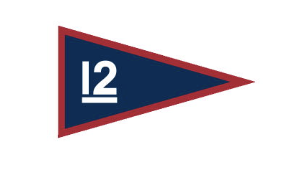
SPERRY SAILS

The Classic Yacht Owners Association is an exempt organization as described in Section 501(C) (3) of the Internal Revenue Code. Donations and membership fees are charitable contributions and tax-deductible. Employer Identification Number: 81-285925
© Copyright 2024. All Rights Reserved. Website by risingT, LLC.
- Private Charters: (401) 849-5868
- Ticketed Sails: (401) 846-9886
l2 US 23 Heritage
1970 america’s cup contender and ocean racing champion.
Skippered by Charley Morgan, Heritage sailed a close campaign for the 1970 Cup but was ultimately eliminated by Intrepid in the Defender’s series. Heritage’s 1970 Cup campaign was only the “first act” before hitting her stride as an offshore racer.

l2 US 22 Intrepid
1967 & 1970 winner of the america's cup.
Twice Winner of the America’s Cup, the incomparable Intrepid is close to the hearts of many sailors. 12 US 22 is one of the most famous racing yachts of all time.

l2 US l7 Weatherly
1962 america's cup winner.
The acclaimed yacht designer Philip Rhodes, designed only one 12 Meter in his career, the Cup winner Weatherly ! One of only three surviving wooden America’s Cup Defenders in the world, Weatherly is a true legend in American sailing history.

l2 US 11 Gleam
1937 vintage 12 - trial horse in 1958 & 1962 cups.
Built in 1937, the vintage 12 Meter Gleam was influential in the development of the longest running class of yachts used in the America’s Cup. The legendary lineup of helmsmen, Briggs Cunningham, Lee Loomis and Harold Vanderbilt, became so fond of Gleam that they built their own 12 Meters to join the class.

l2 US 6 Onawa
A classic beauty.
Onawa was designed by the renowned naval architect and pioneering aircraft designer, W. Star-ling Burgess. She was number 6 of 6 nearly identical Twelve Meter Class yachts built for prominent members of the New York Yacht Club in 1928.

Tender to Intrepid
Scout is a 19 foot rigid hard bottom inflatable. Designed and built by RIBCRAFT in MA to be a luxury tender for use in all conditions. This rib provides unmatched performance for a boat of its size.

Other Classic Yachts
America’s Cup Charters is a full-service yacht charter company. We represent distinctive classic sailing and power yachts available for charter out of Newport, RI and along the New England coast.
Have questions?
©2022 America’s Cup Charters. All Rights Reserved.

- CLASSIFIEDS
- NEWSLETTERS
- SUBMIT NEWS
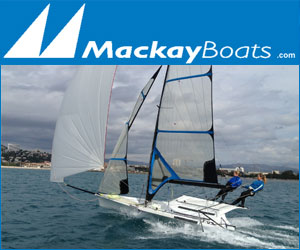
12 Metre World Championship scheduled for Newport, Rhode Island in 2023
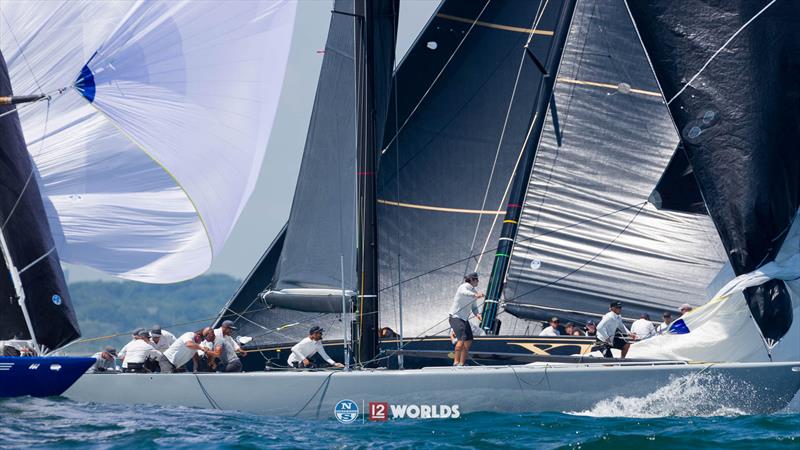
Related Articles
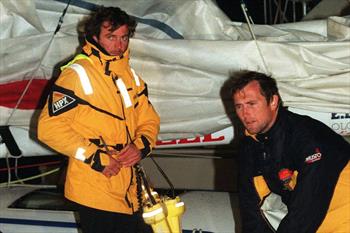

The 12m Class and the America’s Cup By Halsey C. Herreshoff
Credit: www.herreshoff.org
The 150-year history of the America’s Cup, the oldest and most distinguished prize in world sport, is summarized from the author’s vantage point of belonging to a family of boat designers and builders who contributed to the dominance of American yachts from the beginning into the 1980s. Particulars and performances of the most important designs are described from AMERICA to the current International America’s Cup Class.
Introduction
The America’s Cup is the Holy Grail of yacht racing. It is much more. This Cup, in competition for a period of 150 years, is the oldest and most distinguished trophy in all sport, outdating the World Cup, Davis Cup, Stanley Cup, Walker Cup, and all others of significance. Excepting the lavish excesses of big time modern professional sport, more talent, effort, and money have been devoted to the America’s Cup than for any other sport competitions. From the standpoint of naval architecture, America’s Cup intensity has inspired countless design breakthroughs, fallout from which benefit all yachts today to an extent generally unrealized by those who sail. Here, a highly focused pursuit of excellence has provided quality, boldness, and dedication to be the best. The most elegant hull lines, most efficient construction, best sails, and most skillful sailing techniques have evolved from America’s Cup competition.
For 132 years (1851 to 1983), the United States enjoyed the longest winning streak in all sport. There were close calls but always the U.S. won the series and most of the individual races. Through that time, American yachts were generally, though not always, the fastest; thus, it may be fairly stated that victories followed very much from technical prowess.
As with any ship design, a sailing yacht embodies many necessary elements, which must dovetail to accomplish its mission. What is nice about America’s Cup design is that the only mission is speed, maneuverability and reliability to best a single match race rival around a closed course. Size, weight, wetted surface, hull form, light but strong construction, efficient rigs with good sails, sea kindliness and maneuverability are necessary. In general the successful boats embody acceptable or superior selections in the above categories. Bold innovation has been rewarded, but nearly always, extremes have failed. In a series of yacht races encompassing generally a variety of wind and sea conditions, an overall good boat wins.
It is appropriate to divide America’s Cup history into seven logical chronological divisions. The outstanding or most interesting yacht of each period will be addressed herewith. Listed below are the America’s Cup competitions by era with the names of the winning and defeated yachts respectively. In each case the focus yacht is in boldface type.
The l2-Metre era: 1958-1987
Following World War II, the conventional wisdom on both sides of the Atlantic was that the America’s Cup was done. The world was rebuilding and there seemed little prospect of funding further J boats given their assumed greatly accelerated cost. The Cup itself remained the pride of the New York Yacht Club, continually on display in the trophy room of the 44th Street Club House. Most of us expected it to just remain there for a long time, perhaps never to be raced for again.
Enter Commodores Henry Sears and Henry Morgan of the New York Yacht Club. By petitioning the Supreme Court of the State of New York, they modified the Deed of Gift to allow smaller yachts without the previous demand that challengers must cross the ocean on their own bottoms. It was agreed to compete in the International 12-Metre Class, which had provided excellent racing for several years before the war. Designed to the rather tight specifications of the International Rule, these boats did not really fit the grand traditions of the Cup but nevertheless provided nearly three decades of some of the finest match racing ever.
1958-1987: The 12-Metres 1958 COLUMBIA vs. SCEPTRE 1962 WEATHERLY vs. GRETEL 1964 CONSTELLATION vs. SOVEREIGN 1967 INTREPID vs. DAME PATTIE 1970 INTREPID vs. GRETEL II 1974 COURAGEOUS vs. SOUTHERN CROSS 1977 COURAGEOUS vs. AUSTRALIA 1980 FREEDOM vs. AUSTRALIA 1983 AUSTRALIA II vs. LIBERTY 1987 STARS & STRIPES vs. KOOKABURRA III
I can write more knowledgeably about the 12-Metre era than any other, as I was an active participant for 25 years and an observer for the full 29 years. Through acquaintance with Harry Sears, I was excused from other duties as a naval officer to sail aboard COLUMBIA, the 1958 Cup Defender, as bowman. Sailing aboard the 12’s in most of their seasons, I participated in four America’s Cup series, a total of 20 races; it was all about the greatest fun I’ve ever had.
The International Rule is an inelegant arbitrary formula that controls and restricts the design of these boats within narrow limits. There is a minimum length, maximum draft, maximum rig heights, and a set relation between length and displacement. Scantlings first in wood and later in aluminum are tightly controlled by specifics of the rule, Nevertheless, innovation in design particularly by Olin Stephens brought about nearly continual improvement of the boats, and the design edge of the United States long seemed to assure retention of the Cup as it did over many matches through 1980.
Curiously, some of the finest racing of all was in the finals of the first selection trials between COLUMBIA, sailed by Briggs Cunningham and designed by Sparkman & Stephens against Stephens prewar 12-Metre VIM. These were great tactical battles with racing margins of a few seconds in many races. The Cup race itself that year was a walk; SCEPTRE was a quite inferior design that had never faced competition before the match. As had happened a few times before, WEATHERLY, a weak American boat, won in 1962 by the brilliance of Bus Mobacher, her skipper. That was the first year of an Australian challenger and GRETEL won a race demonstrating the aggressive posture of Australian sailors.
Another S&S yacht, CONSTELLATION won in 1964. She was a quite elegant all-round boat, which was selected as Cup Defender over the large and powerful AMERICAN EAGLE, which was only superior in heavy weather. This should have been a tip off to the future but the true significance of having to design the smallest possible 12-Metre for Newport conditions was not generally appreciated until Australia II lifted the Cup in 1983. The reason 12-Metres form an exception to the axiom “design big” is the idiosyncrasy of the rule, particularly the prescription of increased displacement with length.
Olin Stephens’ INTREPID of 1967 was a breakthrough yacht. Wetted surface was drastically reduced with a shorter keel and separate rudder and the boat had numerous refinements. With outstanding management and the skill of Mosbacher again as skipper, INTREPID was unbeatable. The quest for further breakthroughs led to some peculiar and unsuccessful designs over the next two seasons.
The 1970 match was saved by repeat defense of INTREPID. In 1974, Olin Stephens designed another very fine boat, COURAGEOUS. Built of aluminum under new scantling rules, COURAGEOUS was powerful and superior in a breeze but did not easily defeat INTREPID, striving for a third defense. The selection trials reduced to a memorable sudden-death race in a 30-knot northeast breeze that COURAGEOUS won through both superior speed and better sailing. While I personally believe that Stephens’s 1977 boat, ENTERPRISE, was a further improvement in the same direction, Ted Turner sailing COURAGEOUS beat her out for the defense. Though not of demonstrably different dimensions, FREEDOM of 1980 seemed very superior. One difference was lower freeboard – providing a lower center of gravity and less hull windage. The new ingredient was a brilliant program of development of sails, gear and crew established by skipper Dennis Conner over a two-year program. The success of the program altered America’s Cup procedures from then on. Even with that, FREEDOM did lose one of the races of the match principally owing to a light-air advantage of Australia employing a rule-beating mainsail that gave her superior windward speed in light air.
Then, in 1983, the unthinkable happened in Newport when AUSTRALIA II beat LIBERTY in “The Race of the Century,” the sudden-death seventh race of that match. AUSTRALIA II was the best 12-Metre yacht to sail in the 25-year history of competition at Newport. Her extraordinary and controversial winged keel was, of course, the conspicuous feature. The ballyhoo about that masked the significant facts that AUSTRALIA II was the first boat to go to minimum 12-Metre length and displacement and that she had significantly less wetted surface than any other Twelve; this latter fact won the Cup! Less wetted surface followed naturally from a smaller boat but also from a keel of radically small planform. Where that had failed 13 years earlier in VALIANT with a conventional keel, it succeeded in spades on AUSTRALIA II because the winged keel provided sufficient hydrodynamic lift (side force) without the conventional large area. Because 12’s have draft limited by a function of length, they crave more draft or the equivalent effect. The lift-enhancing action of the “end plate” wings provided that very effectively.
While the racing ended at Newport in 1983 with the victory by the wonderful AUSTRALIA II, the subsequent events are equally interesting. Dennis Conner took charge again and with a brilliantly conceived and executed plan won back the Cup the first time sailing Twelves in the challenging waters of western Australia. The final STARS & STRIPES was a one-weather boat, big and powerful for the consistent “Doctor” (strong winds) of Freemantle. Others did not have the strength of their convictions to go with such a big and powerful boat. Dennis’s crew and tactics were admirable in this most wonderful challenge at a spectacular sailing locale.
The one-weather quality of STARS & STRIPES was abundantly clear from her total failure to win light-weather 12-Metre races in European waters later in 1987. An AUSTRALIA II type boat was needed there or would have been for continued 12-Metre races in Newport or San Diego.

- Entertainment
- Rex Reed Reviews
- Awards Shows
- Climate Change
- Restaurants
- Gift Guides
- Business of Art
- Nightlife & Dining
- Observer Advertising Guidelines
- Advertise With Us
Why a 12-Meter Yacht Is Your Perfect Starter Boat
The 12-meter category has it all: a historical pedigree, an active global fleet, a cohesive class association and a charter program that is both accessible and affordable..
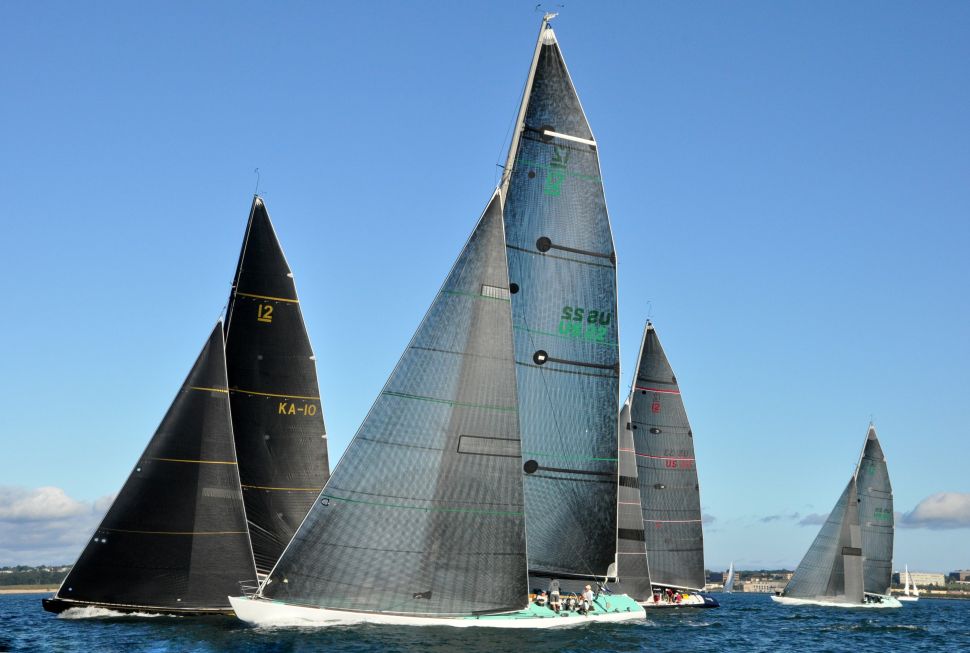
The world of sailing has some great competitions. There is the America’s Cup, Volvo Ocean, Vendee Globe, Extreme Sailing and Sydney to Hobart races. The downside is you’re probably not going to get to sail in them—ever. They’re either just for pros, or so difficult and expensive they’re reserved for millionaires and billionaires.

Sign Up For Our Daily Newsletter
Thank you for signing up!
By clicking submit, you agree to our <a rel="nofollow noreferer" href="http://observermedia.com/terms">terms of service</a> and acknowledge we may use your information to send you emails, product samples, and promotions on this website and other properties. You can opt out anytime.
But the 12-Meter class of boats (usually referred to as Twelves, maybe out of affection, maybe because the spelling of “meter” is subject to global debate) wants no part in that. This venerable category has it all: a historical pedigree second to none (they sailed in the 1908 Olympics), an active global fleet, a cohesive class association and a charter program that is both accessible and affordable. These are boats that look and feel like boats. They do not fly on foils or capsize from instability.
The Twelves were first launched in 1907, and they are still being built today. They’re about 70 feet long and are designed to what is known as a “box rule.” They’re not all the same, but within their sub class their weighting and measurements are similar that they can race against each other. In this way, design innovations, like modern underbodies and new rigs, are incorporated into the class. New and old boats have their own divisions.
Sailing’s legends like Olin Stephens have designed 12-Meter boats. Vim, a Stephens design built in 1939, is one of the most beloved Twelves of all time, and it’s still racing and winning in Europe. Philip Rhodes designed Weatherly, and she is still actively racing and available for charter in Newport, Rhode Island. Sparkman and Stephens designed Columbia, Intrepid and one that Ted Turner made famous in the 1977 America’s Cup, Courageous . All are still racing. And Columbia and Intrepid are available for charter.
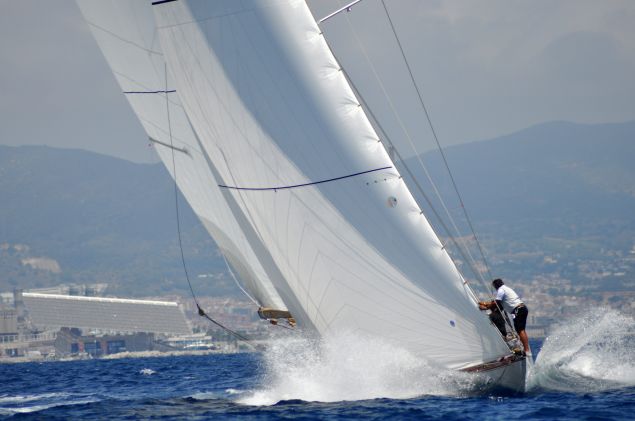
The world’s most skilled skippers made their marks in the 12-Meter class: Dennis Connor; Ted Hood, Emil (Bus) Mosbacher; and of course, Ted Turner. All of them sailed Twelves in the America’s Cup.
The height of 12-Meter fever was during the 1958 to 1987 America’s Cup years—a long run by any standard. The Twelves were perfect for the post-J-Boat era. Unlike the Js, which are mammoth, Twelves require a far smaller crew, are a fraction the size and cost, and can be modified easily as racing technology advances. These boats kept the Cup safely in American hands, demonstrating to the world, in the waters off Newport, that America had the best boats and best sailors.
Now a series of regattas have been organized to celebrate the revival of the Twelves. This summer saw three: two in Newport and one in Martha’s Vineyard. All presented under the umbrella of “Road to the Worlds.” That “road” will end in 2019, in Newport, with the World Championships. Peter Gerard, Vice President of the America’s fleet, believes there will be 30 or more boats sailing for the trophies. Twelve of the boats are based in Newport, but the fleet is truly international; there are Twelves in 17 countries.
During the past few years, several old Twelves have been restored to their former glory. Others have had major upgrades. Freedom, an Olin Stephens design, has been completely redone. Defender, a David Pedrick design, has been salvaged and made new again. Defender’ s owner, Dennis Williams, has also restored Victory 83. As he sees it, “We’re only guardians of these boats. We want to leave them better than we found them.” Several other owners agree.
For example, the Ben Lexcen-designed— Challenge XII, the sister ship to the revolutionary winged keel Australia II that snatched the Cup away for the first time in 1983—made its 2017 debut after a complete refit, winning its first regatta. Enterprise, another yacht from the fabled Sparkman and Stephens design board, is currently “in the shed” for a complete refit, in anticipation of being on the starting line in June 2018.
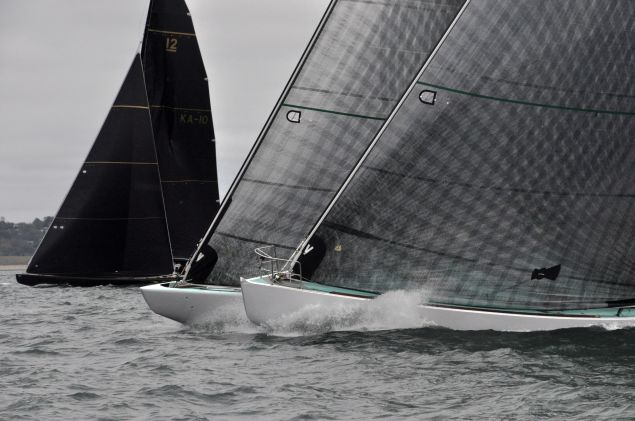
Peter Gerard pointed out that Twelves attract aficionados of yachts and history, not to mention beauty. “These yachts are thought to be amongst the most beautiful ever afloat. Their lines are graceful and they sail through the water like a proper yacht,” he said. The class is sailed by all Corinthian (amateur) crews. Clearly this is not about who has the biggest checkbook.
The fleet is divided into four groups: Grand-Prix, Modern, Traditional and Vintage. There is also an antique category. The groupings reflect age, rudder and sail configurations, and a whole host of rating rule constraints. The hoped-for result is competitive racing without resorting to handicapping.
Aside from owning one of the Twelves, a one-half to million-dollar a year proposition between boat purchase and campaign costs, there is a way to participate in this exciting class revival: charter.
And for this, there’s a very active fleet. Current boats available for charter include Weatherly, Nefertiti, American Eagle, Intrepid, Columbia, Heritage, Gleam, Onawa, and Northern Light. One can rent them for a regatta, or for just a sail around the bay with family and friends. The Twelves are often used for corporate team-building exercises.
I have been fortunate enough to sail on chartered Twelves in regattas—once for the Opera House Cup in Martha’s Vineyard, and once for a guys’ weekend in Newport’s Narraganset Bay. I was also part of a group that sailed a Twelve in New York Harbor for a fundraiser. I had a blast each time. The Twelves are big but not too big, strong but not too overwhelming, powerful but not uncontrollable. Their graceful lines translate into a smooth knife through the water .
You can feel the historical lineage of all the legendary sailors who designed, built or skippered a Twelve. Their nautical spirits whisper to you through the rigging.
As Gerard says, “It’s hard to sail a more beautiful boat with such incredible history than a Twelve.” I would have to agree.
Jonathan Russo has been a sailing enthusiast for 30 years. He sails his Sabre 38 “Sachem” and an Etchell’s from the Shelter Island Yacht Club. He has written about sailing and racing for Soundings, Scuttlebut and The Shelter Island Reporter.com.

- SEE ALSO : Inside Observer’s Nightlife + Dining Power List Party: Hospitality’s Greats, Full-Circle Moments and Spicy Rigatoni
We noticed you're using an ad blocker.
We get it: you like to have control of your own internet experience. But advertising revenue helps support our journalism. To read our full stories, please turn off your ad blocker. We'd really appreciate it.
How Do I Whitelist Observer?
Below are steps you can take in order to whitelist Observer.com on your browser:
For Adblock:
Click the AdBlock button on your browser and select Don't run on pages on this domain .
For Adblock Plus on Google Chrome:
Click the AdBlock Plus button on your browser and select Enabled on this site.
For Adblock Plus on Firefox:
Click the AdBlock Plus button on your browser and select Disable on Observer.com.
The Available 12 Meters
The following 12 Meters are available for charter in the 12 Meter Heritage Regatta 2023. Each of these famous and historic yachts has a great story. You will meet the crew, become familiar with the stories and this 12 Meter will become part of your sailing career.
These 12 Meter are also available for other regattas like the Opera House Cup in Nantucket, the Edgartown 12 Meter Regatta in Martha’s Vineyard, or the 12 Meter North Americas in Newport.
US 19 Nefertiti
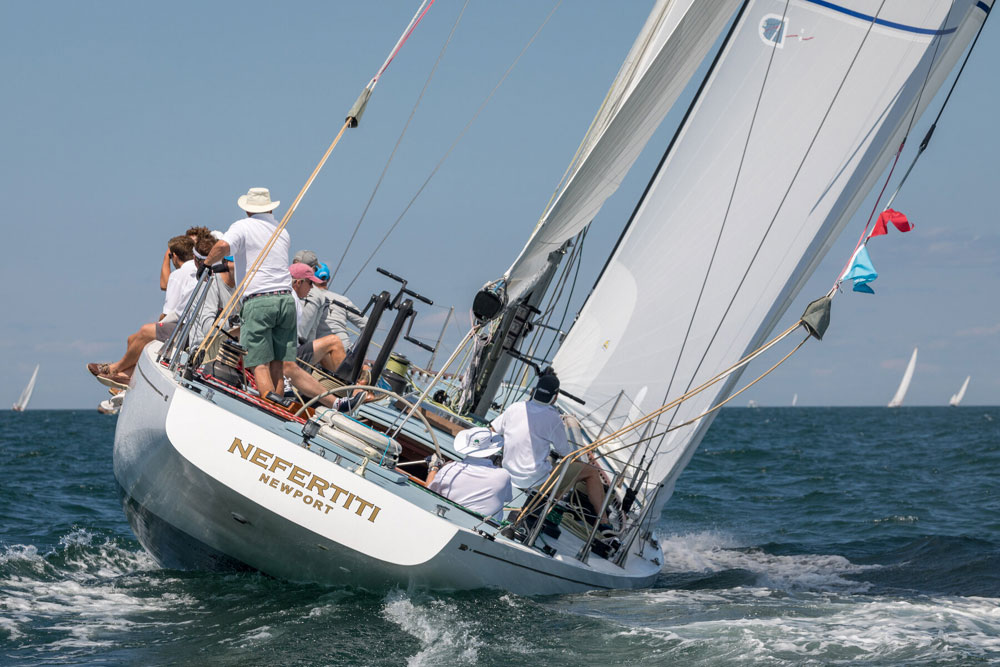
US 21 American Eagle
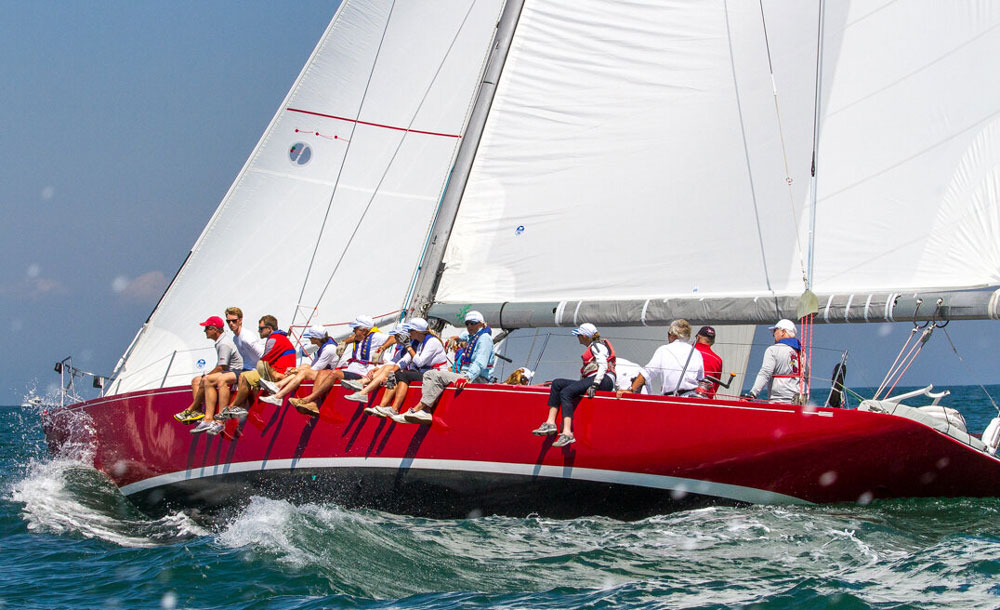
US 17 Weatherly

US 42 America II
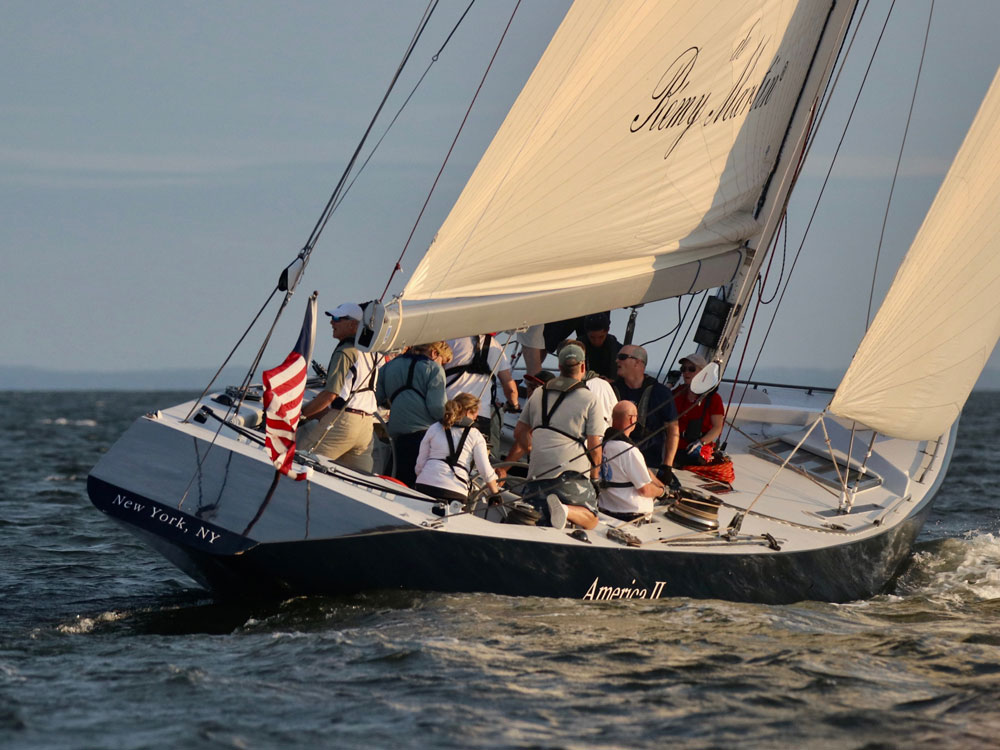
Charter Fee
The charter fee for the 12 Meter Heritage Regatta is $3,500 per session.
The sessions are:
1) Thursday, June 15, 2023 – 6 pm to dusk (2 races scheduled) Corporate Championship – Organizations and companies can field a team to race
2) Friday, June 16, 2023 – 6 pm to dusk (2 races scheduled) Women’s Championship –All-women teams are encouraged to compete on this day
3) Saturday, June 17, 2023 – Afternoon Session – 11 am to 2pm Club Championship – This is a championship for all social, university and yachting clubs
4) Saturday, June 17, 2023 – Evening Session – 4 to 7 pm Club Championship – This is a championship for all social, university and yachting clubs
- If you charter a 12 Meter for the full day on Saturday, the charter fee for your 2 sessions is discounted from $7,000 to $5,000.
- If you charter a 12 Meter for the Thursday or Friday races, you can also upgrade your charter to have use of the 12 Meter for the entire day. This will let you bring more people sailing onboard during the day. You can use the additional sailing time to take friends or co-workers sailing past the Statue of Liberty, or use it for your team to do some race training. The upgrade fee is $1,500 and makes your full day charter $5,000.
All monies raised through the charter fees goes towards supporting these historic America’s Cup 12 Meters. Thank you for sailing onboard and helping to preserve these important pieces of American yachting tradition.
Comments are closed
JAVASCRIPT IS DISABLED. Please enable JavaScript on your browser to best view this site.
Historic America's Cup Paintings
The extraordinary yachting art of russ kramer.

Marine Artist Russ Kramer of Mystic, Connecticut, specializes in fine art recreations of famous yacht races such as the America’s Cup and scenes of Gilded Age yachting life. Combining historic, maritime and figurative themes, his paintings are often from a thrilling first-person viewpoint, or a compelling birds-eye view. He has painted all the early America’s Cup races from the first, the Yacht America’s 1851 defeat of an entire fleet of the finest English yachts through the J-boat yacht Ranger of 1937. Two 12-meter races, yacht Weatherly in 1962 and yacht Intrepid in 1970 are also depicted. Russ has also painted several of the early and famous Bermuda Race yachts such as Tamerlane, Hutoka and Finisterre. All of Russ Kramer’s yacht paintings are available in limited edition prints on both paper and canvas, signed and numbered by the artist. Canvas prints are enhanced by the artist using a textured gel varnish which gives them the look and feel of an original painting. Russ has been featured in Yachting magazine, Sail magazine, Wooden Boat magazine and Classic Boat magazine among many others. He also works on commissioned yacht portraits and family experiences on the water. He is the current President of the American Society of Marine Artists, and is represented by the Maritime Gallery at Mystic Seaport, Connecticut, the J. Russell Jinishian Gallery in Fairfield Connecticut, the Roger King Gallery in Newport, Rhode Island and the ICON Gallery in Alexandria Virginia. Click on any image above to see more information on a famous America’s Cup race and order a print of any of these America’s Cup paintings.
America’s Cup art America’s Cup paintings Americas Cup fine art prints America’s Cup prints America’s Cup history Yacht America America’s cup 1851 Yacht Magic America’s cup 1870 Yacht Columbia America’s Cup 1871 Yacht Livonia America’s Cup 1871 Yacht Madeleine America’s Cup 1876 Yacht Mischief America’s Cup 1881 Yacht Puritan America’s Cup 1885 Yacht Mayflower America’s Cup 1886 Yacht Volunteer America’s Cup 1887 Yacht Vigilant America’s Cup 1893 Yacht Defender America’s Cup 1895 Yacht Columbia America’s Cup 1899 Yacht Columbia America’s Cup 1901 Yacht Reliance America’s Cup 1903 Yacht Resolute America’s Cup 1920 Yacht Enterprise America’s Cup 1930 Yacht Weetamoe America’s Cup 1930 Yacht Whirlwind America’s Cup 1930 Yacht Weatherly America’s Cup 1962 Yacht Intrepid America’s Cup 1970

IMAGES
COMMENTS
Weatherly (US 17) is a 12-metre racing yacht that was an unsuccessful defense candidate for the 1958 America's Cup and victorious defender in the 1962 America's Cup. Design. Weatherly is a keel sloop designed to the 12-metre Rule. She was designed by Philip Rhodes and built by Luders Marine Construction Company at Stamford, ...
2019: Weatherly (US-17) won the 2019 Opera House Cup at Nantucket, MA. 2020: Weatherly (US-17) was purchased by Steve Eddleston *Content courtesy: The Twelve Metre Class by Dyer Jones & Luigi Lang. Jump to International Twelve Metre Yacht Club, Newport Station Fleet page for Weatherly
The 115 year-old International 12 Metre Class encompasses a living history of racing yacht design by the world's foremost naval architects including Olin Stephens, Clinton Crane, William Fife III, Philip Rhodes, Johan Anker, Ben Lexcen and more who pushed their designs to the very limits of innovation. The resulting boats represented the ...
Weatherly was built by the Luders Marine Construction Company in 1958. Designed by famed naval architect Philllip Rhodes, this 12 Meter Class sloop was built for the purpose of defending the 1958 America's Cup. Despite losing in 1958, Weatherly returned and became the victorious defender in the 1962 America's Cup.
The acclaimed yacht designer Philip Rhodes, designed only one 12 Meter in his career, the Cup winner Weatherly! She is stunning to see under sail, with long overhangs and the finely tapered ends of a classic. Beautifully appointed below decks, she glistens with raised mahogany paneling, tufted leather seating, and the warm glow of varnished wood.
Weatherly's owner/skipper Steve Eddleston, who also serves as Commodore of the 12 Metre Yacht Club Newport Station, said his work will be cut out for him. "It's always exhilarating to be out on the water with our beautiful boat and our skilled and determined team sailing against other world famous 12 Metre yachts of such historic ...
The 12 Metre yacht Weatherly was named in September, 2012 to the National Register of Historic Places. (Photo Credit Onne van der Wal). The National Register is the Federal Government's official list of properties throughout the United States whose historical and architectural significance makes them worthy of preservation. Weatherly was the ...
The 112 year-old International 12 Metre Class encompasses a living history of racing yacht design by the world's foremost naval architects including Olin Stephens, Clinton Crane, William Fife III, Philip Rhodes, Johan Anker, Ben Lexcen and more who pushed their designs to the very limits of innovation. ... Weatherly, US-17 photo by Duncan G ...
America's Cup Charters. Sail with the largest fleet of America's Cup Winners in the world. Come race, train, celebrate or just relax aboard our legendary Classic America's Cup 12 Meter yachts. Private Charters.
The 1958 12 Metre sailing yacht Weatherly has obtained federal recognition for its contributions to the history of naval architecture, engineering, and recreation. Edward F. Sanderson, Executive Director of the Rhode Island Historical Preservation and Heritage Commission, announced in September that the National Park Service has listed Weatherly on the National Register of Historic Places.
Weatherly is also significant as an early and notable example of the 12-meter class of racing yachts and of wooden and laminate yacht construction. Weatherly is a 12-meter class sloop built in 1958 for the purpose of defending the America's Cup. Measuring 69 feet overall, she is of double planked wooden African mahogany over white oak frames.
1937 Vintage 12 - Trial horse in 1958 & 1962 Cups. Built in 1937, the vintage 12 Meter Gleam was influential in the development of the longest running class of yachts used in the America's Cup. The legendary lineup of helmsmen, Briggs Cunningham, Lee Loomis and Harold Vanderbilt, became so fond of Gleam that they built their own 12 Meters to ...
Weatherly's owner/skipper Steve Eddleston, who also serves as Commodore of the 12 Metre Yacht Club Newport Station, said his work will be cut out for him. ... The 12 Metre Yacht Club will further involve the community through its partnership with the Boys & Girls Clubs of Rhode Island, giving underserved children a chance to learn about the ...
Yachts such as Columbia, Weatherly, Vim, Intrepid, Courageous, Freedom and Stars and Stripes are known worldwide. The 12s inherited the Cup mantle from the dinosaur-sized, crew of 30, J-Class boats. ... Maximum and minimum parameters on mast height, draft, beam and headsail height are applied to 12 Metre racing yachts to ensure that there is ...
It covers all 12 Metre yachts built with winged keels and all constructed after 1983. Australia II, launched in 1982, was the first wing keeled 12 Metre so is considered the first of this division. ... Weatherly, designed by Philip Rhodes, successfully defended the America's Cup in 1962, and is also sailing and racing today in Newport.
1962 WEATHERLY vs. GRETEL 1964 CONSTELLATION vs. SOVEREIGN 1967 INTREPID vs. DAME PATTIE 1970 INTREPID vs. GRETEL II 1974 COURAGEOUS vs. SOUTHERN CROSS 1977 COURAGEOUS vs. AUSTRALIA ... AUSTRALIA II was the best 12-Metre yacht to sail in the 25-year history of competition at Newport. Her extraordinary and controversial winged keel was, of ...
The height of 12-Meter fever was during the 1958 to 1987 America's Cup years—a long run by any standard. The Twelves were perfect for the post-J-Boat era. Unlike the Js, which are mammoth ...
The charter fee for the 12 Meter Heritage Regatta is $3,500 per session. If you charter a 12 Meter for the full day on Saturday, the charter fee for your 2 sessions is discounted from $7,000 to $5,000. If you charter a 12 Meter for the Thursday or Friday races, you can also upgrade your charter to have use of the 12 Meter for the entire day.
Something went wrong. There's an issue and the page could not be loaded. Reload page. 770 Followers, 176 Following, 24 Posts - See Instagram photos and videos from Weatherly US-17 12 Meter Yacht (@weatherly12meter)
Yr. Launched Launched Name Designer Builder; AUS 01: KA-1: 1962: Gretel: Alan Payne: Lars Holvorsen Sons. Pty. Ltd. AUS 02: KA-2: 1966: Dame Pattie: Warwick J. Hood
The others, Weatherly (12 Meter US-17), Easterner (12 Meter US-18) and Vim (12 Meter US-15), ... In 2017, Columbia was awarded the Ted Hood trophy which goes to the most winning 12-meter yacht. In 2018 took 1st in class at the New York Yacht Club Rolex series & Newport Trophy. She then went on to take 1st place in the Panerai Classic Yacht ...
Weatherly holds a currently valid 12 Meter Class certificate. As required by the 12 Meter rule at the time of her construction, she was built to Lloyd's 100 A1 standards for wooden yachts. Her tonnage is 24 gross and 23 net. Weatherly is constructed of double-planked African mahogany over white oak frames on 10" centers, fastened
Two 12-meter races, yacht Weatherly in 1962 and yacht Intrepid in 1970 are also depicted. Russ has also painted several of the early and famous Bermuda Race yachts such as Tamerlane, Hutoka and Finisterre. All of Russ Kramer's yacht paintings are available in limited edition prints on both paper and canvas, signed and numbered by the artist.